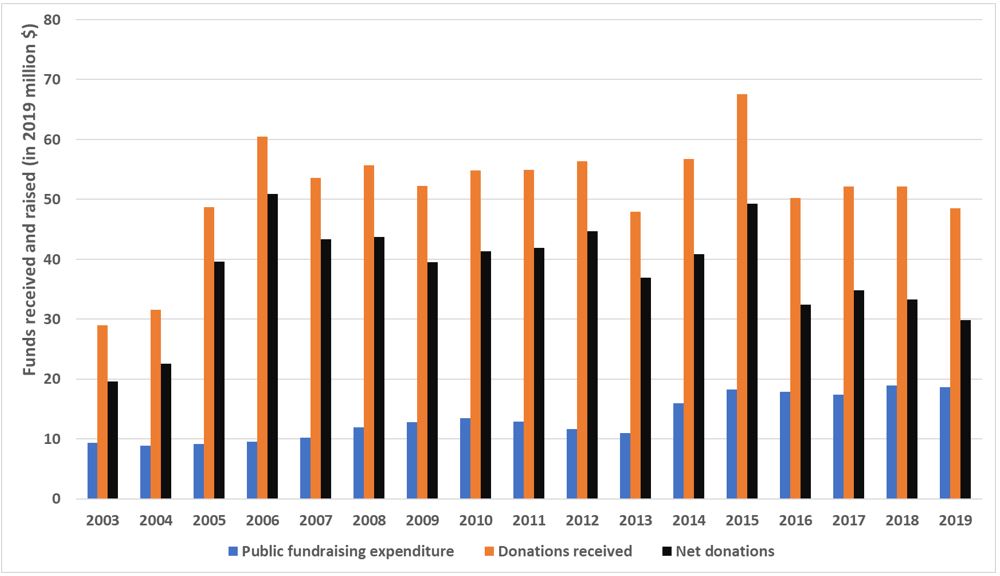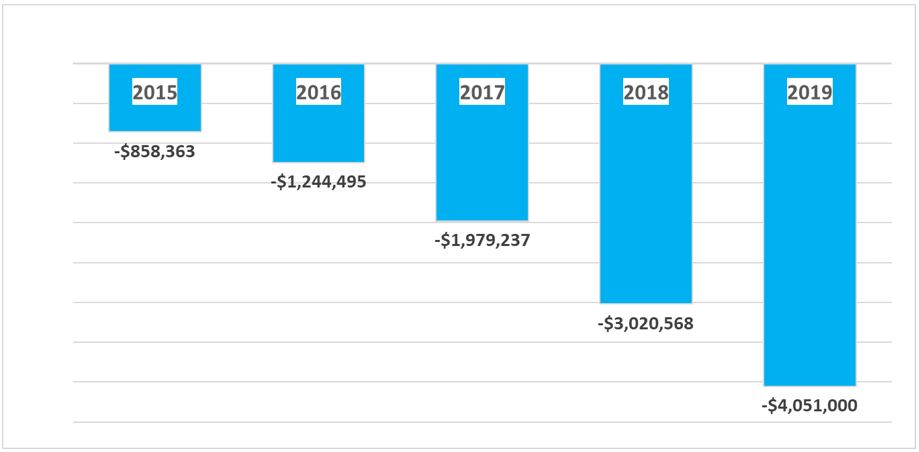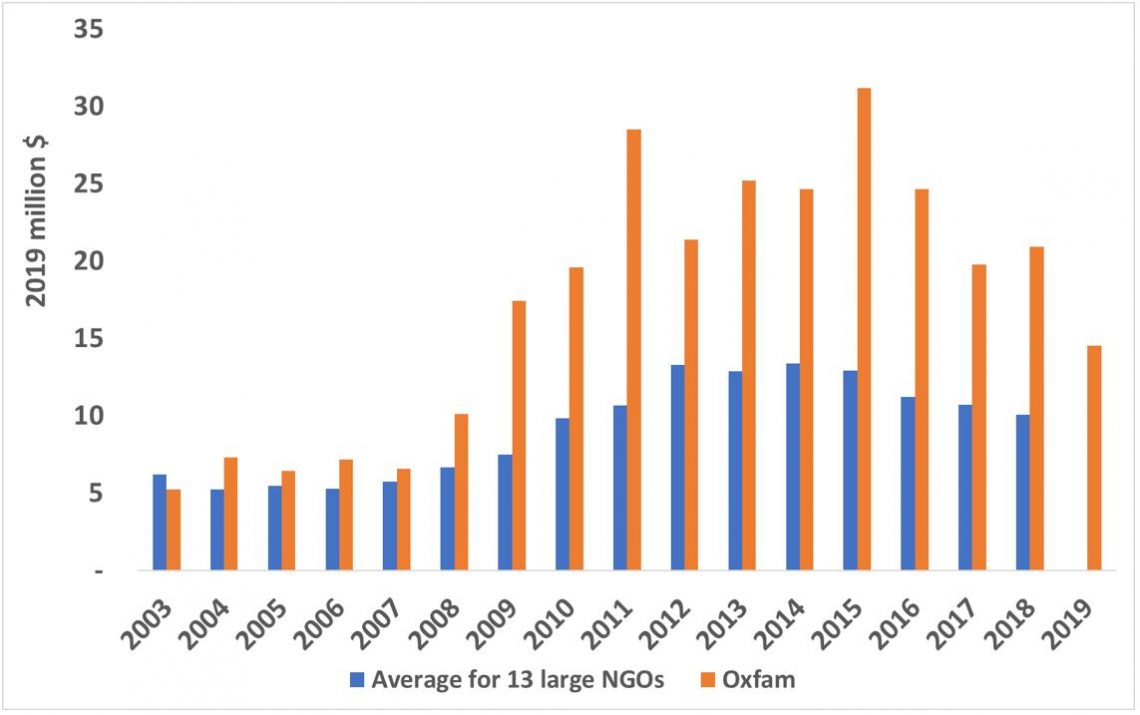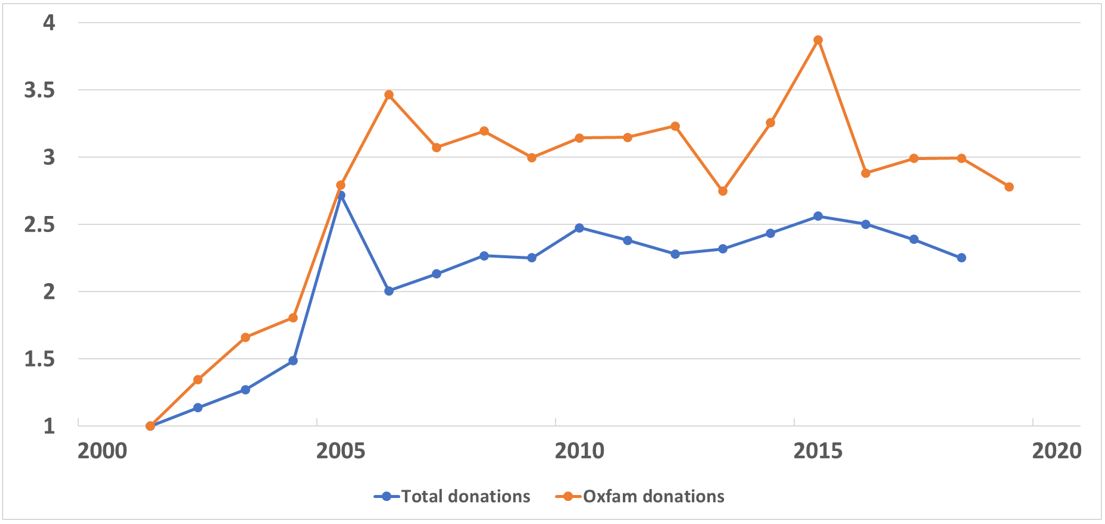
The first Oxfam shop in Oxford, UK. (Credit: Matt Brown/Flickr CC BY 2.0)
Oxfam Australia’s woes: a sign of the times?
By Stephen Howes and Sherman Surandiran
19 June 2020
Oxfam Australia is a very important part of this country’s international development sector. It is one of Australia’s oldest development NGOs (created in 1953 as Food for Peace), and one of its biggest – the fourth largest in 2018 in terms of public donations. It is also one of the most innovative. For example, the iconic (and recently closed) Oxfam shops are one of the first examples of a development NGO funding its operations through social enterprise: there were 22 Oxfam shops as early as 1978.
Oxfam’s recent announcement to halve its staff count caught many by surprise. Are the organisation’s troubles unique to it, or are they a sign of the times? In this post, we run through four contributory factors, using our post-2000 Australian development NGO database. (Note that we have data up to 2019 for Oxfam, but only up to 2018 for development NGOs as a group.)
As Terence Wood has pointed out recently, public donations to Australian development NGOs have been falling since 2015. Oxfam has not escaped this general trend; to the contrary, it has been experiencing an extreme version of it.
Longer term, it is not all doom and gloom. As the figure below shows, Oxfam has actually outperformed the sector in terms of public donations (donations, gifts, bequests and legacies). Even in 2019, Oxfam raised 2.8 times as much in public donations as it did in 2001 ($48 million compared to $17 million, and that is after adjusting for inflation – in 2019 prices). The sector as a whole (that is, all ACFID members and the two largest non-ACFID members: Compassion and MSF or Médecins Sans Frontières) raised just over twice as much ($929 million in 2018 compared to $412 million in 2001).
That’s the good news. The bad news is that, while there is a lot of volatility in Oxfam’s donations from year to year (see data notes at the end of the article if you are interested), once adjusted for inflation, donations seem to be falling rather than rising after the surge in donations associated with the Asian Tsunami in December 2004.
Inflation-adjusted public donations: Oxfam and the sector (2001=1)
The second problem Oxfam has faced is its historically low and falling return on fundraising. In the early 2000s, as the figure below shows, Oxfam was able to raise a lot more without spending much more. But in the past few years, Oxfam has spent more on fundraising but raised less. Gross donations from the public fell by 14% compared to 2012, but net donations (gross funds minus fundraising expenses) fell by one-third, back to below the 2005 surge levels.
Oxfam: funds received and spent on fundraising
Again, Oxfam is not alone. The top 15 NGOs in terms of donations received in 2000, which include Oxfam, were selected to analyse the fundraising efficiency trends of large NGOs (public funds raised to funds spent on public fundraising). The Australian Red Cross was excluded due to partial data. As the next figure shows, the other 13 large NGOs (excluding Oxfam and ARC) were on average much better at raising funds than Oxfam, but also experienced large falls in fundraising efficiency post 2005.
Oxfam has traditionally had one of the lowest fundraising efficiencies of the largest NGOs. For the period covered, it never ranked better than 10th amongst the 14 in the study (the labels in the graph below show Oxfam’s ranking among its peers). In 2018, it was second from the bottom in terms of fundraising efficiency, with only $2.80 raised for every $1 spent. This might not sound too bad, but this ratio acts as a social constraint for NGOs. Reduce it too far, and you become open to the accusation that you are spending wastefully. Oxfam had no way to spend itself out of its fundraising predicament.
Fundraising efficiency: Oxfam and other major donors
Note: Labels show Oxfam’s ranking among the top 14 NGOs (it and the other 13) for fundraising efficiency. Weighted average used for 13 major NGOs.
The third factor that hurt Oxfam is unique to it. Its shops have, from its income statements, incurred increasing losses over the past few years, reaching about $3 million in 2018 and $4 million in 2019, in inflation-adjusted terms. Oxfam began to close down its famous shops in May 2019.
Oxfam’s net income from commercial activities (in 2019 $)
Finally, Oxfam’s Australian government funding also declined. Again, Oxfam actually outperformed the sector in attracting government grants, but experienced a sharp decline from 2015 onwards. Other NGOs also suffered as the Australian government cut its aid budget, but, whereas the average large NGO experienced a decline in government funding of 22% from 2015 to 2018, Oxfam experienced a cut of 33%, with further large cuts in 2019.
Australian government grants to Oxfam and 13 large NGOs
Note: Large NGOs not receiving government grants are excluded from the calculation of the average grant received for that year (Compassion – all years, and MSF and UNICEF – some years).
The Oxfam UK Haiti scandal occurred in February 2018, and clearly 2019 was a bad year for the organisation, in terms of both government grants and public donations. (The Australian government has since withheld funding from Oxfam Australia that was to be channelled to Oxfam UK.) Oxfam’s commercial losses are also its alone – though they speak to the difficulties NGOs in general face in sustaining social enterprise success. Other factors, however, are clearly sector-wide phenomena: long-term falling donations, fundraising efficiency, and government funding.
When you realise that, as the final figure below shows, Oxfam suffered a combined loss of net revenue (gross revenue minus fundraising expenses minus commercial expenses) of 21% between 2014 and 2019, and of 16% in 2019 alone, then you understand why it is cutting staff so drastically. This analysis doesn’t suggest that every second job in Australia’s development NGO sector is at risk, but it also shows that Oxfam’s problems are not its alone. Difficult times clearly lie ahead for many organisations.
Oxfam’s net revenue and net expenditure (in 2019 million $)
Notes: The data in this article comes from our Australian development NGO database, and from Oxfam’s annual reports. All data used in this article is available from public sources, but some has been collected in collaboration with ACFID. The financial year varies across NGOs. Oxfam’s fiscal year ends in March (so 2019 runs from April 2018 to March 2019), but prior to 2016 ended in June. Its 2016 annual report provided financial figures for the nine months from July 2015 to 31 March 2016. To promote comparability across years, the 2016 Oxfam figures have been scaled to a full year in this blog post by multiplying the numbers for that year by 1.33. This is only an estimate. Income was very high in 2015 due to Cyclone Pam and the Nepal earthquake.
About the author/s
Stephen Howes
Stephen Howes is Director of the Development Policy Centre and Professor of Economics at the Crawford School of Public Policy at The Australian National University.
Sherman Surandiran
Sherman Surandiran was a Research Officer at the Development Policy Centre until July 2021.


